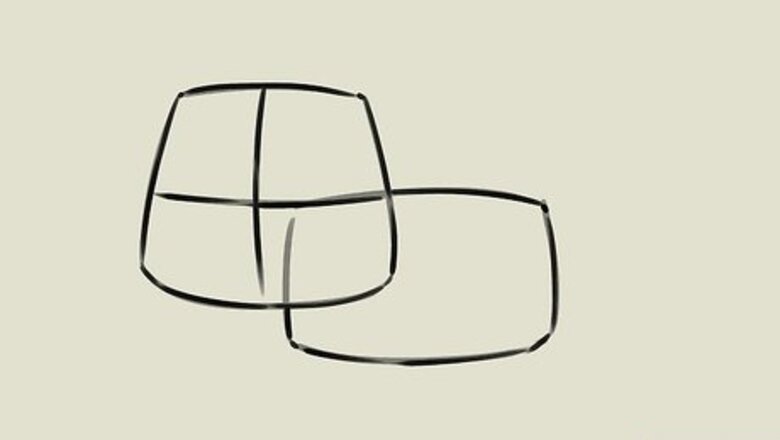
views
Drawing a Cute Cartoon Kitten
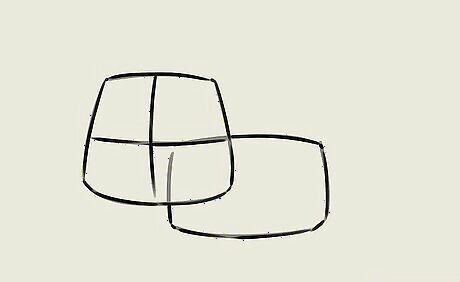
Make an outline of the kitten’s head and body. Use a trapezoid shape with softer edges for the head, and mark a cross inside that same shape. Use a rectangle for the body. Notice that kittens have bigger heads in proportion to the body as compared to a full grown cat. The cross in the face should help you determine where the eyes, nose, and mouth go. The middle point of the cross should be at the approximate middle of the face. Note that the head should overlap the body. The top line of the body should roughly match the horizontal cross-line of the face.
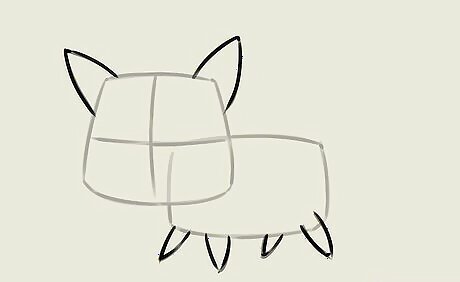
Add cat ears and limbs. Sketch a draft of the kitten’s limbs. Each limb should be a rounded triangle coming off the bottom of the body rectangle. Note that the legs on the "far" side of the kitten should be slightly smaller than those on the "near" side. Similarly, draw two large triangles over the top corners of the head. For a cartoonish look, these triangles should be bigger than those made for the legs.
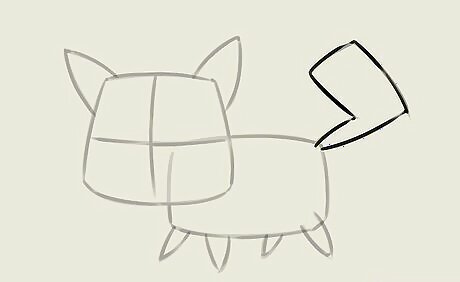
Sketch a rough outline of the kitten’s tail. You can draw a wavy, rounded tail or a more angled one depending on personal preference. Either way, the tail should have at least one bend in it; do not draw the tail perfectly straight.
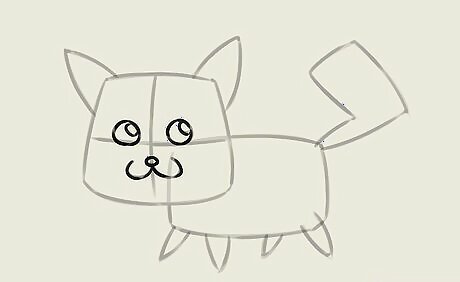
Draw the face. Using the cross inside the square as guide, draw two small circles for the eyes, placing them evenly on either side of the vertical center and just above the horizontal center. Add the nose and mouth. The nose should land on the vertical center and rest below the horizontal center. The mouth should look like a rounded "W" with the center attached to the bottom of the nose.

Darken desired lines of the head and body from the outline you made earlier. You can draw slim curved lines for a furry effect. Add three straight whiskers on each of the kitten’s cheeks.
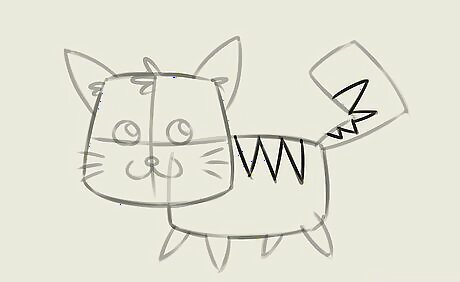
Consider adding patterns to the coat. Many cats have striped fur, so you can add this detail if you want. Draw a few triangular stripes on the kitten's back and tail.
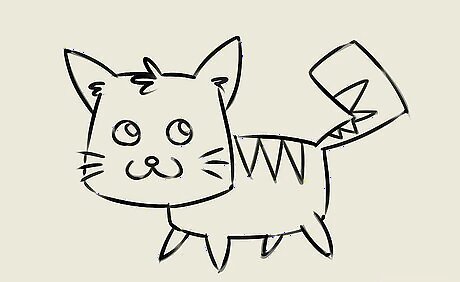
Erase unnecessary lines. This includes overlapping lines and the cross-lines of the face.
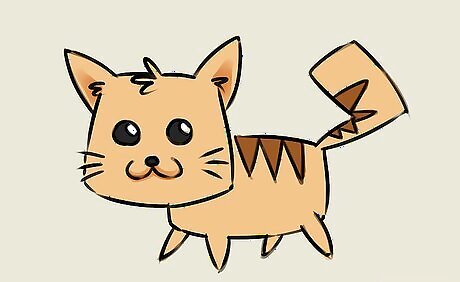
Color the drawing. You can use any colors desired. Consider giving the kitten light brown fur. If you added stripes, make the stripes a slightly different shade.
Sketching a Kitten Playing with a Ball
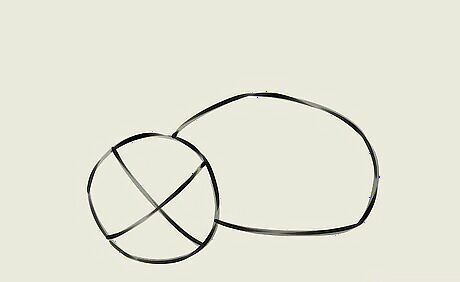
Sketch an outline of the body and head. Draw a circle for the head with a crossed line inside and use an oblong shape for the body. Since the finished kitten will be lying on its back, the top of the head should be positioned slightly lower than the top of the body. Instead of drawing the cross-line at the vertical and horizontal center, angle it so that it looks like an "X" meeting at the center of the circle. The oval body should be about twice as long as the head (but roughly the same height).
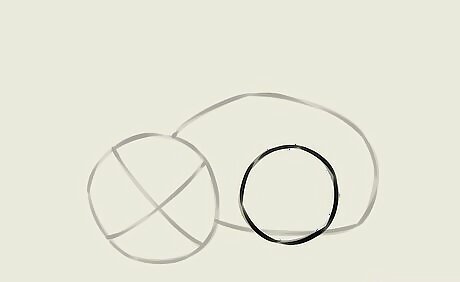
Sketch a circle in the middle portion of the kitten’s body. This will be the ball the kitten is playing with. Note that this circle should be slightly smaller than the kitten's head.
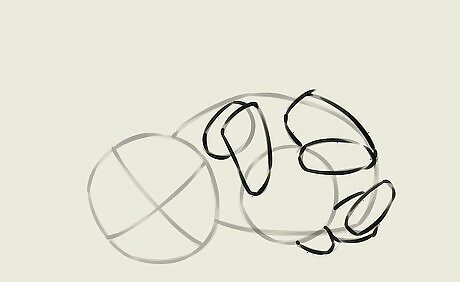
Sketch an outline of the the kitten’s limbs wrapped around the ball. The complexity of the limbs can vary as desired. For best results, most limbs should be drawn in two parts. The "higher" limbs should be a little longer, with lengthwise ovals overlapping on the ball, and rounded ovals connecting the paws to the body of the kitten. The "lower" limbs should be similar, yet smaller, since they would be less visible.
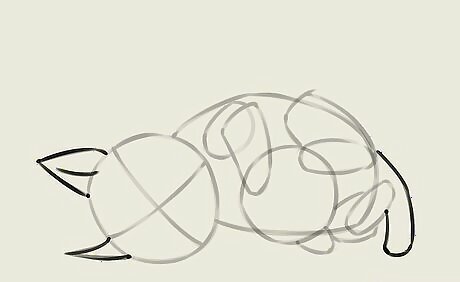
Sketch the ears and tail. The ears should be two triangles coming off the head of the kitten, sticking out horizontally to the side. The tail should be one long, rounded quadrilateral curving around the bottom of the kitten's body.
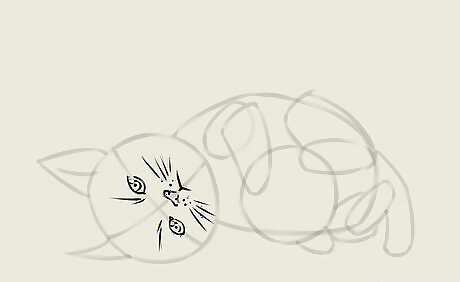
Draw the face. Using the crossed line from your outline as guide, draw the kitten’s eyes, nose and mouth. You can also add the whiskers using long strokes. The eyes should lie on the horizontal center line. The nose should lie on the vertical center line, with the "W" shaped mouth connecting to it at the bottom.
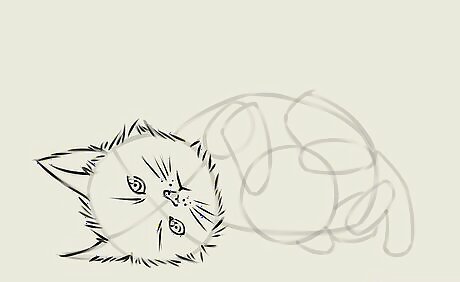
Add fur to the face. Sketch around the kitten’s face using small soft strokes to make it look furry.
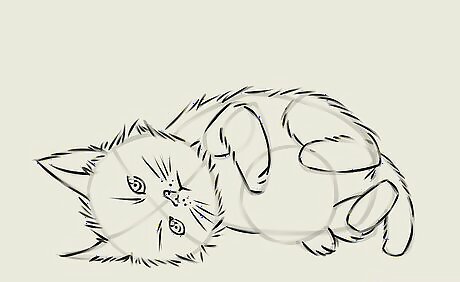
Add fur to the body. Sketch the same short soft strokes in drawing the kitten’s body and tail.
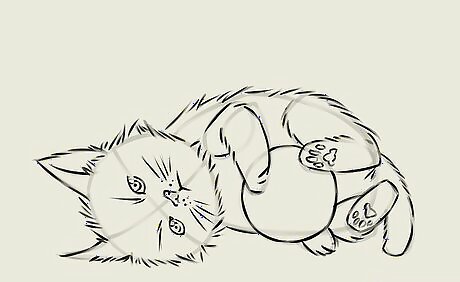
Add details to the kitten’s paws. When viewed from the top, you'll only see straight lines where the toes are. For the back paws (viewed from the bottom), you'll see the actual paw pad. Darken the ball, as well.
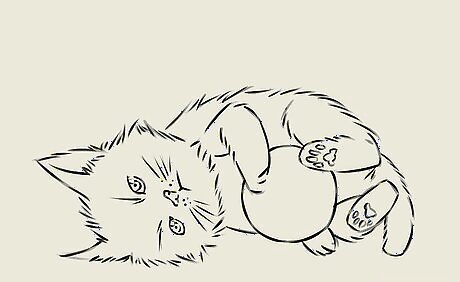
Erase unnecessary lines. Clean the drawing by erasing unnecessary lines from the outline.
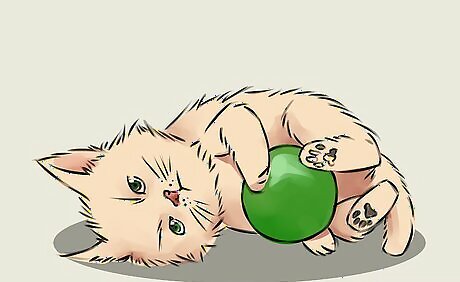
Color the kitten. You can add color as desired. The paw pads, nose, and eyes should vary from the color of the fur. You should also choose a different color for the ball.
Drawing a Realistic Kitten Sitting
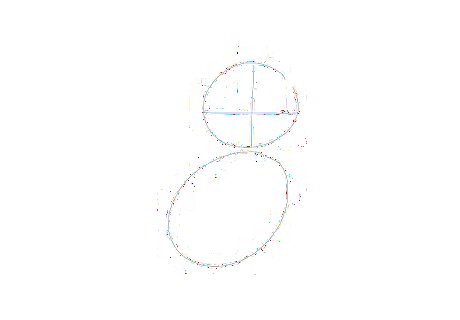
Sketch a circle for the head and an oval for the body. Draw a cross in the circle for the guidelines of the face. Note that the body should only be a little larger than the head, and should be at a slight angle away from the head. Keep the intersecting point of the cross-lines close to the center of the head.
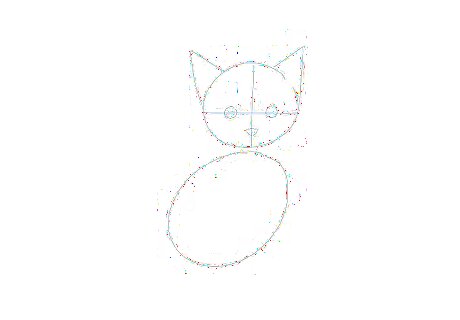
Draw the face. Sketch two circles for the eyes and a half circle for the nose. The eyes should be positioned over the horizontal center line, and should be at equal distance away from the vertical center. The nose should be on the vertical center line and below the eyes.
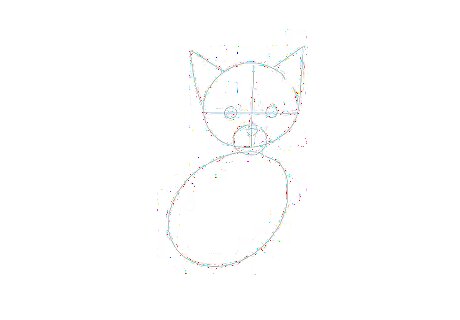
Add the mouth. Sketch a small circle for the mouth area covering as well the nose area. This circle should be below the eyes, yet should completely cover the nose and overlap the bottom of the head circle.
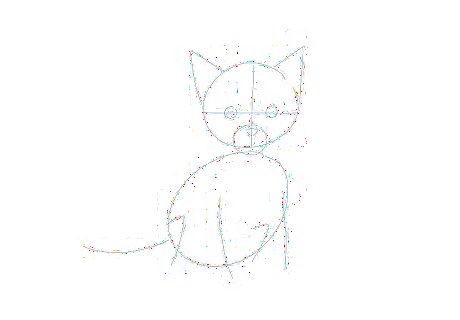
Draw lines for the extremities. This includes the legs and tail. The front legs should be two slightly curved lines coming off the front of the body oval, starting about three-quarters up and extending to the bottom, pointing away from the angle of the body. The back legs should be two arrowhead shapes attached to the bottom of the oval. The tail should be a curved line sticking out from the bottom back of the oval.
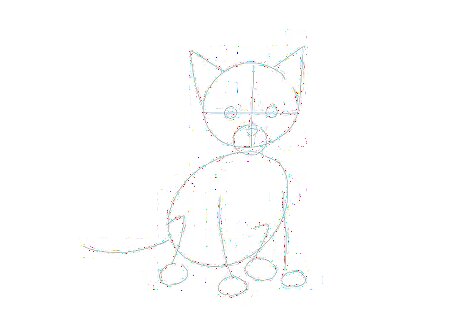
Add the paws as circles. The back of each circular paw should be attacked to the leg lines.
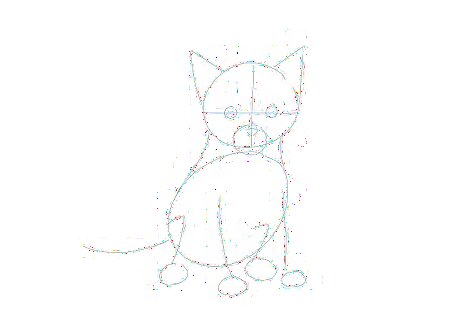
Connect the head with the body. Draw two inwardly curved lines from either side of the head to either side of the body, forming the kitten's neck.
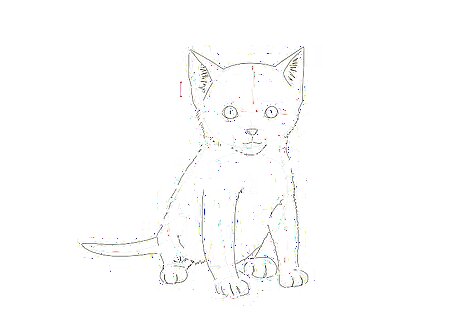
Draw the basic outline of the kitten. Draw thicker shapes around the leg lines and tail line to fill out the limbs. Add curved lines to the front of the paws to look like toes. Add a "W" shaped mouth connecting to the bottom of the nose. You can also "roughen" the overall outline of the kitten with small, jagged strokes, creating the impression of fur.
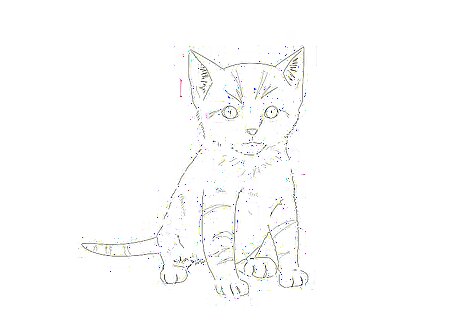
Erase the unnecessary draft detail. Add more details like the fur lines and the pattern of the fur color, if desired. This can include stripes or other details.
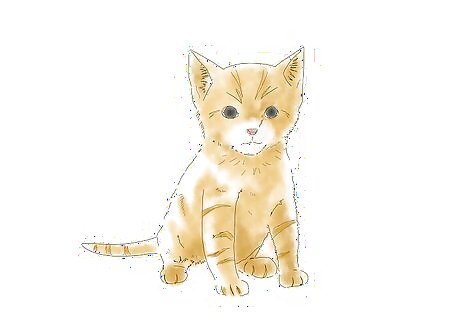
Color the kitten. Use any color you'd like, but make the mouth area slightly lighter so that it stands out. If you added stripes or patterns, color those a separate shade, as well.
Sketching a Realistic Kitten Sleeping

Sketch a circle for the head and an oval for the body. Position them close together; some overlap may even be good. Draw a curved line connecting the body and the head. The body should only be a slight oval, and only slightly larger than the head. The connecting line should reach the approximate middle top of both the head and the body.
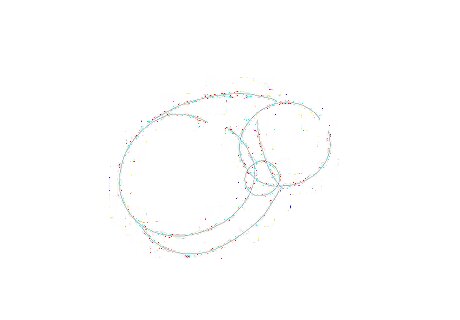
Sketch a circle for the mouth area and a curved line for the tail. The mouth should be a small circle positioned at the bottom of the head, slightly overlapping the body oval, as well. The tail should begin near the back of the body oval, and should follow along the natural curve of the kitten toward the animal's face.
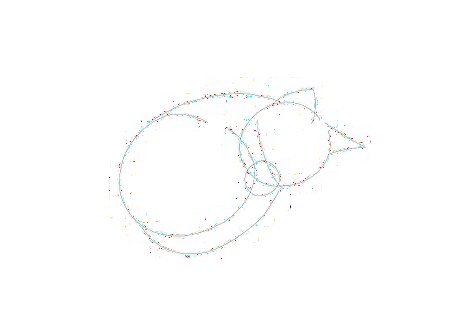
Sketch the ears. The ears should be triangles coming off the top of the kitten's head. Since the kitten is sleeping, the bottom ear should be relatively flat/horizontal, while the top ear should be angled upward and away from the body. Note that the ears should be approximately the same size as the mouth section of the kitten's face.
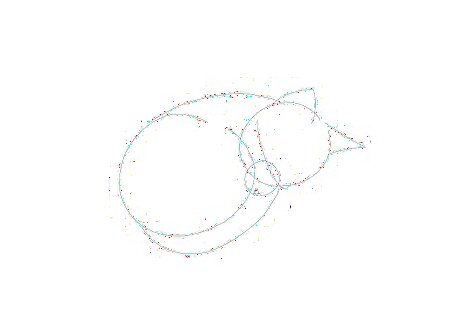
Add the eyes and the nose. The nose should be a small half-circle sitting at the edge of the mouth area. The eyes should be small, straight dashes crossing behind the mouth area and over a small portion of the face. Since the kitten is sleeping, use lines to represent closed eyes instead of circles, which indicate open eyes.
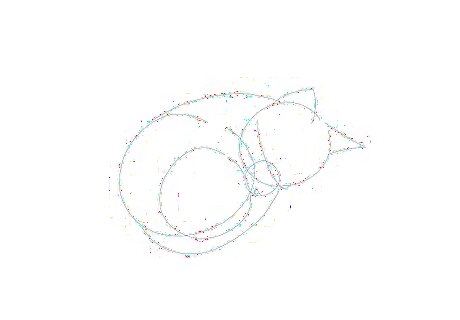
Add the thigh as a circle. Make it about as big as the head, and position it slightly off-center yet overlapping the body. The thigh should just barely brush against the bottom of the mouth area.
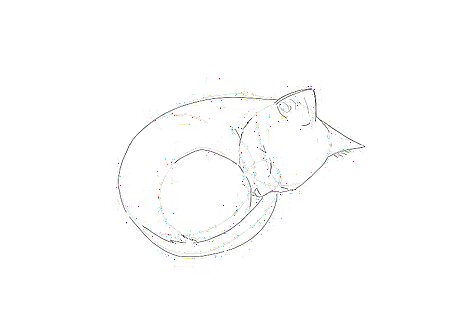
Draw the basic outline of the kitten. Widen and fill out the tail. Darken the top edge of the thigh, as well as the lines smoothing out the connections between the body, head, and ears.
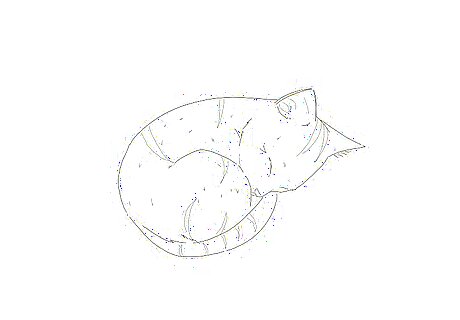
Erase the draft lines. Add more details like the detail of the ears and fur lines. Consider adding thin triangular stripes or other patterns to the fur.
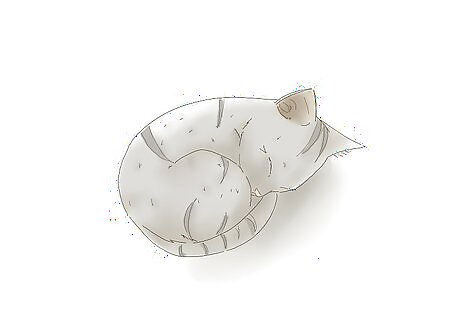
Color the kitten. Use any color desired. Note that the nose should be a different color, as should the top ear, since you'll be viewing the inner ear (this does not apply to the bottom ear; you'll see the outer furry portion of that one). If you added stripes or other details, color those separate shades, as well.




















Comments
0 comment